The United States has more salamander species than any other place in the world, and Georgia is a hot spot for these unusual-looking amphibians. The salamanders found in Georgia are interesting creatures that thrive in various different environments.
Some salamanders are entirely aquatic, never leaving the water, while others are more likely to be found on land. These salamanders can also vary in size, body shape, and color. The one thing that the following 13 salamanders have in common, however, is that you can find them in Georgia.
13 Salamanders In Georgia
Georgia is home to 55 species of salamanders, making it one of the most diverse states in the USA for salamander species. Below, you will find information about the 13 most commonly found salamanders in Georgia.
1. Georgia Blind Salamander
Scientific Name: Eurycea wallacei
Despite its name, the Georgia blind salamander is not just found in the state of Georgia, it can also be found throughout the Southeastern portion of the United States. It reaches lengths of up to 2 inches and has a white body tinted in hues of pink or yellow. Their external gills are red, and they have a long and flat heads.
This salamander lives in subterranean water environments but has learned to adapt to dark caves. Unfortunately, the IUCN (International Union for Conservation of Nature) has listed the Georgia blind salamander as vulnerable due to habitat loss.
2. Hellbender
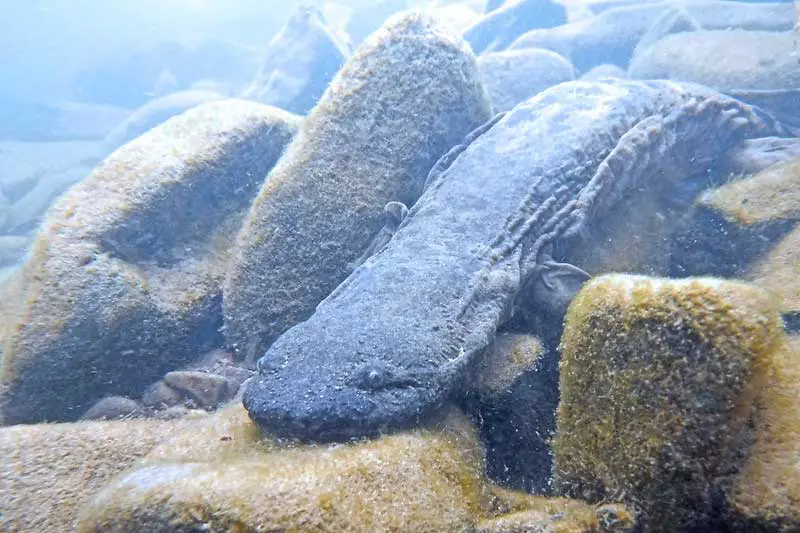
Scientific Name: Cryptobranchus alleganiensis
The hellbender salamander is found in the northern portion of Georgia and is rather large. It can reach up to 29-inches in length and is often found in fast-flowing streams filled with large rocks.
Hellbenders are entirely aquatic, and there are only one species found in the United States. It is the largest salamander in North America and can weigh 5 pounds or more. Hellbenders have a wrinkled body that is brown or dark gray, a flat head, and a tail shaped like a paddle.
3. Common Mudpuppy
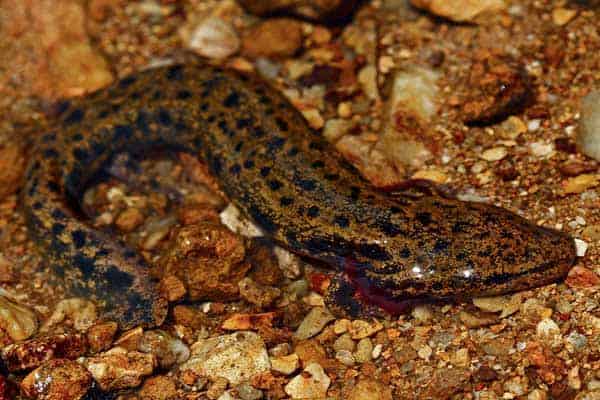
Scientific Name: Necturus maculosus
Even though mudpuppies are more often found in the Eastern parts of the United States, it is not uncommon to find them as far south as Georgia. They are sometimes confused with hellbenders since they have many of the same characteristics. The main difference between the two is their skin. Hellbenders have wrinkly folds in their skin that they breathe through. Mudpuppies, however, breathe through their external gills so their skin is much tighter and smooth-looking.
Also known as water dogs, mudpuppies are entirely aquatic creatures that live in ponds, rivers, and lakes. They can reach lengths of up to 17-inches and weigh less than a pound, and can even live up to 11 years.
4. Mole Salamander

Scientific Name: Ambystoma spp.
Mole salamanders are large, stocky burrowing creatures with bulging eyes and round heads. They can grow anywhere between 3 and 8-inches long and are usually found below the ground. There are 5 different species of mole salamanders found throughout the entire state of Georgia.
5. Newts

Scientific Name: Notophthalmus spp.
Georgia has two species of newts, the striped newt, and the Eastern newt. The striped newt is only found in the wetlands of Georgia and Florida. Both newts are rather small, measuring only about 4-inches in length. They are found in lakes, ponds, and forests, and have rough skin that can be tan, black, or red and are sometimes spotted.
6. Dusky Salamander
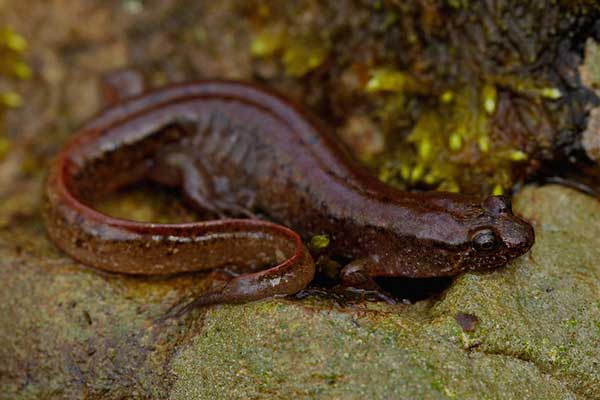
Scientific Name: Desmognathus spp.
The dusky salamander is found throughout streams and seeps found throughout Georgia. It can reach lengths of up to 8 inches long and has smooth dark brown or black skin with various patterns. This salamander’s rear limbs are much larger than its front two limbs, giving it a unique appearance.
7. Spring Salamander

Scientific Name: Gyrinophilus porphyriticus
The body of the spring salamander is pinkish orange to salmon in color with dark splotches. Their bodies are large and stout, and they have light line and dark line that extends from the tip of each eye to the snout. They are found throughout northern Georgia in caves, streams, seeps, and springs.
8. Woodland Salamander
Scientific Name: Plethodon spp.
The woodland salamander lives in forests and the sides of the stream throughout Georgia. They measure up to 8-inches long and have dark gray or black bodies with lighter flecking spots. They are sometimes known as slimy salamanders. Georgia is home to 13 different species of woodland salamanders, including the Plethodon Ocmulgee, which is found in Georgia’s upper coastal plain.
9. Four-Toed Salamander
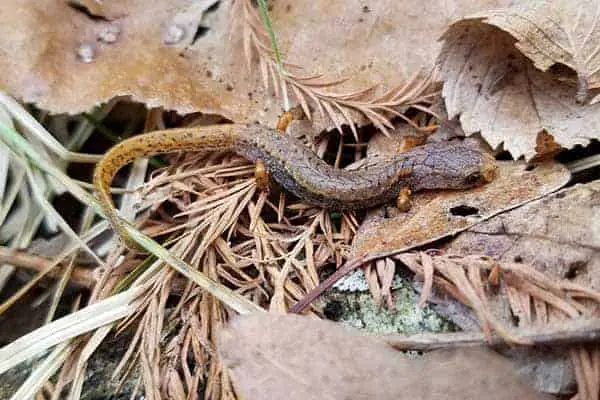
Scientific Name: Hemidactylium scutatum
Four-toed salamanders are named because they only have 4 toes on their hind feet. These small creatures measure about 2 to 4 inches long and are rusty brown in color with black blotches or spots. They are found in the bogs, marshes, fishless ponds, and swamps throughout north-central Georgia. The female four-toed salamander will usually lay their eggs in nests with other four-toed salamander females.
10. Mud Salamander
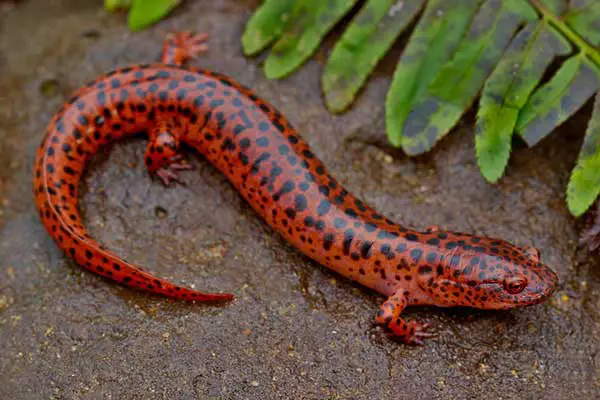
Scientific Name: Pseudotriton spp.
These brightly-colored salamanders have orange or reddish brown skin with dark spots and a stocky body. They measure between 3 and 6 ½ inches in length and are found in streams and forests throughout Georgia. The mud salamander thrives in mud or leaf buds.
11. Green Salamander

Scientific Name: Aneides aeneus
As their name suggests, green salamanders are covered in green-colored splotches with black skin. Their body is flat and measures about 3 to 5 ½ inches long, and their toe tips are square. They are found in rock crevices throughout the northeast and northwest areas of Georgia.
12. Many-Lined Salamander

Scientific Name: Stereochilus marginatus
The many-lined salamander is found along the Atlantic coastal plains of Georgia in woodland ponds, ditches, borrow pits, canals, swamps, and various permanent bodies of water. They are small in size, reaching 2 ½ to 3 inches long, and have slender bodies. They usually have dark streaks or lines running parallel along their bodies, but the lines may be replaced by dark spots.
13. Eastern Tiger Salamander
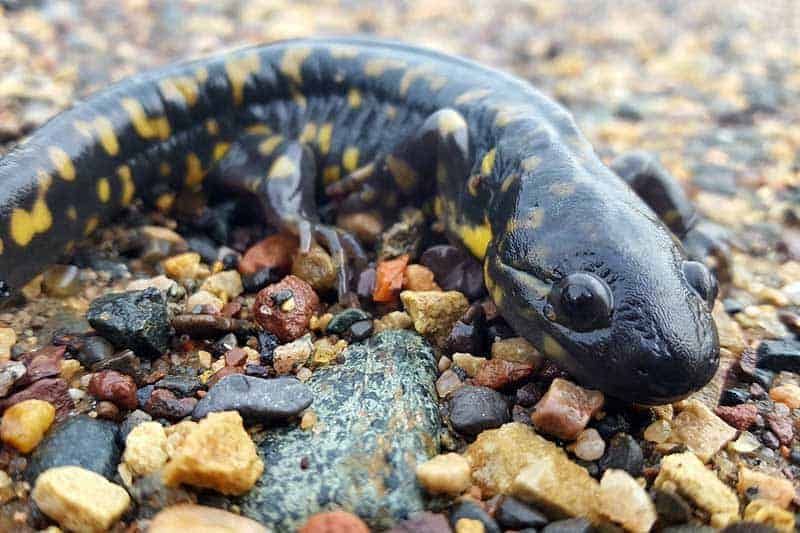
Scientific name: Ambystoma tigrinum
Around 7-8 inches is the average size for this species, but lengths of 13 inches have been recorded before. It’s a mottled brown with lighter brown spots and patches that vaguely resemble the pattern of a tigers stripes.
It’s only found in isolated pockets of Georgia and most common in the southern half of the state, it’s one of the rarer species of salamander hound here.
Adults may be terrestrial or aquatic, with terrestrial adults digging burrows to live in. The terrestrial adults eat many different species, including lots of different invertebrates and even mice. Aquatic adults will eat worms, insects, and tadpoles.
Tiger salamanders are also commonly kept as pets.




